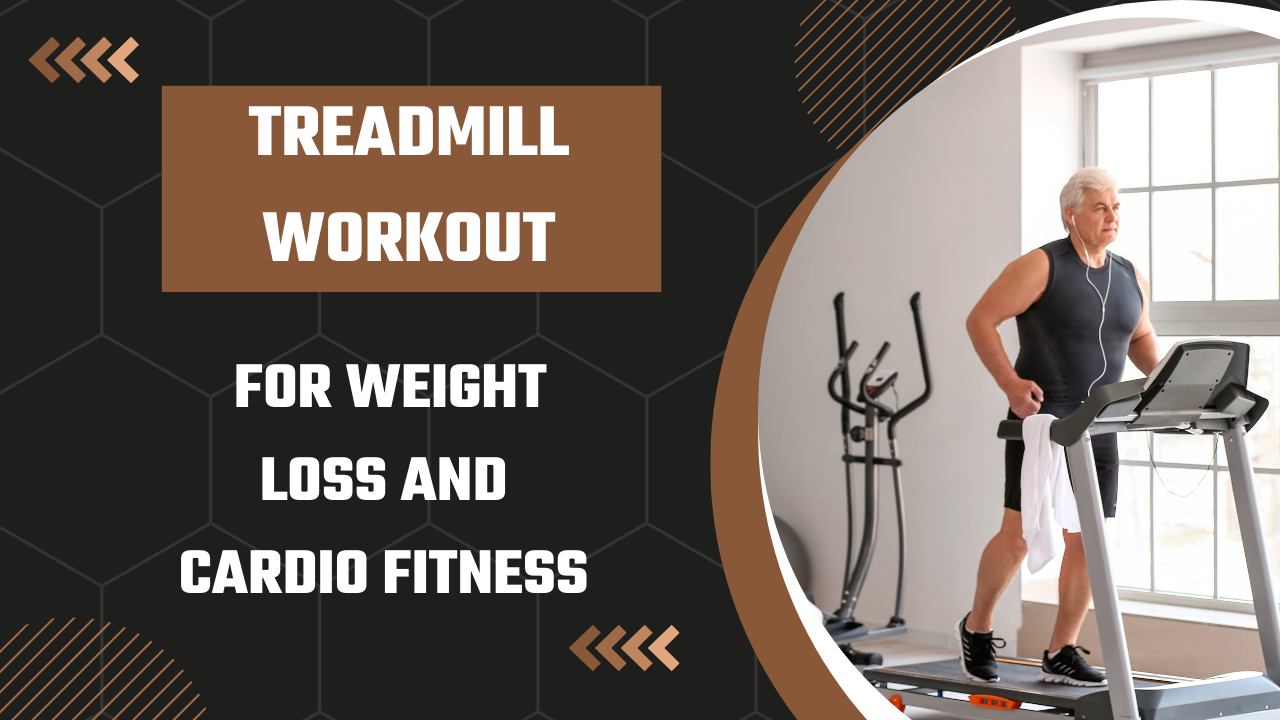A treadmill workout is one of the most effective and accessible ways to improve fitness, lose weight, and build endurance. Whether you’re a beginner or an advanced athlete, the treadmill provides a safe and controlled environment for cardiovascular training. Unlike outdoor running, allow you to adjust speed, incline, and intensity with precision, making it an excellent tool for customized training.
Incorporating treadmill sessions into your routine helps burn calories, strengthen the heart, and boost metabolism. It’s not just about running endlessly at one speed—the treadmill can be used for walking, jogging, sprint intervals, and even incline climbs that simulate hiking. By structuring your properly, you can achieve fat loss, muscle toning, and improved stamina all in one machine.
This article dives deep into the benefits, training methods, and the top 8 treadmill workout tips that will maximize your results. Whether your goal is weight loss, cardiovascular endurance, or improved athletic performance, you’ll find everything you need to make the most out of your treadmill sessions.

🏃 What is a Treadmill Workout ?
A treadmill workout is a structured form of exercise performed on a treadmill to improve overall health and fitness. It is an effective way to enhance cardiovascular endurance, burn calories, and support weight management. Depending on your goals, can include walking, jogging, running, or interval training sessions.
One of the biggest advantages of a treadmill workout is the controlled environment it provides. Unlike outdoor running, where weather or terrain may limit activity, treadmills allow you to adjust speed, incline, and duration based on your fitness level. This flexibility makes it suitable for both beginners seeking a steady pace and advanced athletes aiming for intense performance training.
Versatility is another reason treadmill workouts are so popular. From fat-burning incline walks to stamina-boosting sprints, you can design routines that align with your specific needs. With consistency, a treadmill workout can become a powerful tool for building endurance and achieving fitness goals.
🏃 Why is a Treadmill Workout Effective ?
A treadmill workout is highly effective because it offers consistent and measurable progress. Most modern treadmills come with built-in features such as calorie tracking, distance measurement, and heart rate monitoring. These tools make it easier to track your improvements and stay motivated, whether your goal is fat loss, stamina, or overall fitness.
Another major advantage of is its reliability. Unlike outdoor exercise, it is not affected by weather conditions, uneven terrain, or safety concerns. Whether it’s raining, snowing, or extremely hot outside, you can still complete your treadmill workout indoors without interruption, making it a convenient year-round option.
What makes treadmill workouts even more powerful is the ability to control pace, incline, and intensity with precision. This customization allows you to target specific goals, such as burning fat, building endurance, or improving performance. With consistency, becomes one of the most effective forms of cardio training.
🏃 When Should You Do a Treadmill Workout ?
The best time for a treadmill workout truly depends on your personal routine and fitness goals. Many people choose the morning because exercising early helps kickstart metabolism, boost energy, and set a positive tone for the rest of the day. Morning also provide a sense of accomplishment that carries into daily activities.
On the other hand, evening are equally beneficial, especially for those who prefer exercising after work. By this time, your body is warmed up and fueled, allowing you to perform at a higher intensity. Evening sessions can also act as a great stress reliever, helping you unwind and sleep better.
Ultimately, the key to success lies in consistency. Whether you schedule your treadmill workout in the morning or evening, sticking to a regular routine will deliver long-term results. Find the time that fits your lifestyle and make it a sustainable habit.
🏃 How Does a Treadmill Workout Help ?
A treadmill workout is one of the most effective ways to enhance cardiovascular health. Regular walking or running on the treadmill strengthens the heart, improves blood circulation, and lowers the risk of heart-related conditions such as hypertension and heart disease. This makes it a safe and reliable cardio option for long-term fitness.
Beyond heart health, a treadmill also strengthens key muscle groups in the body. The calves, glutes, hamstrings, and quadriceps are all engaged during movement, while the core works to maintain balance and posture. With consistency, this routine builds endurance, making daily activities feel easier and less physically demanding.
For weight management, a treadmill is particularly powerful. It burns calories efficiently, supports fat loss, and boosts metabolism long after the session ends. When combined with proper nutrition and hydration, treadmill training provides a sustainable pathway to better fitness, improved strength, and long-term health.
🏃 Where Can You Do a Treadmill Workout ?
A treadmill workout can be performed in a variety of settings, making it one of the most versatile forms of exercise. Many people choose gyms or fitness centers where they can access advanced treadmills that include preset programs, heart rate monitors, and incline adjustments. This professional environment can also provide extra motivation from the presence of other fitness enthusiasts.
For those who prefer privacy and flexibility, a home treadmill is a perfect solution. Having a personal treadmill allows you to schedule workouts at your convenience, whether early in the morning or late at night. It also removes common barriers like bad weather, crowded gyms, or lack of time.
Ultimately, the success of a depends on consistency rather than location. Whether you exercise at home or in the gym, the key is choosing a setting that fits your lifestyle. This ensures long-term commitment and steady progress toward fitness goals.
Top Tips on Treadmill Workout
⭐ Warm Up Before Every Session

Starting your treadmill with a warm-up is crucial for preparing your body and mind. A 5–10 minute warm-up at a gentle walking speed of 2–3 mph helps your muscles loosen up and gradually increases blood circulation. Without warming up, you risk muscle stiffness or even injury once you start running at higher intensities.
A warm-up also helps your body transition smoothly from a resting state to an active one. It slowly raises your heart rate, increases oxygen supply, and improves joint mobility. This makes your feel easier and more controlled, especially in the first few minutes.
For the best results, start with a slow walk, then gradually increase the pace to a light jog. By easing into your treadmill workout, you not only protect your body from unnecessary strain but also maximize performance throughout the session.
Benefits: A warm-up reduces the chance of strains or injuries, enhances flexibility, and raises your heart rate gradually. This ensures you don’t shock your body with sudden exertion, making your treadmill smoother and more enjoyable.
Ingredients: Begin with a slow walk at 2–3 mph, then transition into a light jog. This progression primes your muscles for more intense intervals, sprints, or incline training. Think of it as the foundation for everything that follows in your treadmill workout.
⭐ Use Incline to Burn More Calories
Adding incline to your treadmill workout transforms an ordinary walk or run into a calorie-torching exercise. Walking or jogging at a 5–10% incline activates muscles in your glutes, calves, and hamstrings while simulating the challenge of uphill terrain. This extra resistance pushes your body to burn more calories in less time.
Incline training doesn’t just target your lower body—it also strengthens your cardiovascular system. By pushing against gravity, your heart and lungs work harder, improving overall endurance. This makes your treadmill more efficient for fat loss and fitness progression.
To implement incline training, alternate between flat walking and incline walking. For beginners, start at 3–5% incline and gradually increase as you adapt. Over time, you’ll notice stronger legs, higher stamina, and faster results from your treadmill workout.
Benefits: Adding incline simulates outdoor conditions like hill running, improves endurance, and provides a more challenging treadmill workout. It also builds strength in your posterior chain, leading to better balance and stability.
Ingredients: Beginners can start with a 3–5% incline, while advanced users can push up to 8–10%. Alternate between flat walking and incline intervals (e.g., 2 minutes flat, 2 minutes incline). Consistency with incline training guarantees faster fat-burning results.
⭐ Try Interval Training

Interval training is one of the most effective ways to maximize the benefits of a treadmill workout. It involves alternating between short bursts of high-intensity running and slower recovery periods. For example, sprinting for 30 seconds followed by walking for 1–2 minutes.
This method pushes your body to work at different intensity levels, which keeps your metabolism elevated even after you step off the treadmill. The afterburn effect allows you to continue burning calories for hours, making interval training ideal for weight loss.
Beginners can start with 20-second jogs and 1-minute recovery walks. Advanced runners can sprint at 8–10 mph for 30 seconds, followed by a 1-minute jog. By adding interval training to your treadmill, you’ll improve speed, stamina, and calorie-burning efficiency.
Benefits: Interval training boosts your metabolism, promotes fat burning even after the workout (afterburn effect), and increases overall speed and endurance. It’s perfect for breaking through weight-loss plateaus and improving heart health.
Ingredients: Beginners can start with 20-second jogs followed by 1–2 minutes of walking. Advanced users can sprint at 8–10 mph for 30 seconds, then jog or walk for 1 minute. Repeat this for 20–30 minutes for maximum effect.
⭐ Focus on Posture & Form
Proper posture and form are often overlooked but critical in every treadmill workout. Maintaining good alignment prevents strain and ensures that your muscles work efficiently. Keep your head up, shoulders relaxed, and back straight while running or walking.
Avoid the temptation to lean on the treadmill rails. Gripping the rails reduces calorie burn and creates poor form that can lead to joint pain or muscle imbalances. Instead, let your arms swing naturally to support rhythm and balance.
Engaging your core while running will also help stabilize your body and reduce injury risks. By practicing good posture during your treadmill, you’ll not only burn more calories but also improve breathing and endurance over time.
Benefits: Good posture ensures you get the most out of your treadmill by activating the right muscles. It also reduces the risk of neck, back, or joint pain while making your stride more efficient.
Ingredients: Keep your head up, eyes forward, and shoulders relaxed. Engage your core muscles for stability and allow your arms to swing naturally. Avoid gripping the treadmill rails—let your body do the work.
⭐ Mix Walking and Running
Not every treadmill workout has to be a high-intensity sprint session. Mixing walking and running helps create a balanced, sustainable routine suitable for all fitness levels. Alternating between speeds allows your body to recover while still keeping your heart rate elevated.
Walking and running intervals also help prevent burnout, which is common when workouts feel too intense. This balance makes it easier to stay consistent with your treadmill plan in the long run.
For example, you can walk for 3 minutes, jog for 2 minutes, and run for 1 minute, repeating this cycle for 30 minutes. Such variation ensures you enjoy your treadmill while steadily improving stamina, strength, and endurance.
Benefits: Alternating between walking and running prevents burnout, gradually improves cardiovascular strength, and keeps workouts interesting. It also makes the treadmill adaptable for all fitness levels.
Ingredients: Try a cycle of 3 minutes walking, 2 minutes jogging, and 1 minute running. Repeat this sequence for 30–40 minutes. This balance allows steady progress without overtraining.
⭐ Use the Treadmill for HIIT
High-Intensity Interval Training (HIIT) takes treadmill workouts to the next level. By alternating explosive sprints with short recovery periods, you push your body to burn calories at maximum capacity. A sample routine could be sprinting for 1 minute followed by 2 minutes of walking, repeated 8–10 times.
HIIT is highly effective because it challenges both your aerobic and anaerobic systems. The short bursts of speed elevate your heart rate quickly, while recovery periods train your endurance. This makes your treadmill shorter but more powerful than steady-state cardio.
Beginners can start with 15–20 minutes of treadmill HIIT, while advanced users may extend it to 30 minutes. Incorporating HIIT into your treadmill boosts metabolism, promotes fat loss, and enhances athletic performance.
Benefits: HIIT enhances fat loss, boosts cardiovascular fitness, and increases overall stamina. It also keeps your metabolism elevated long after you’ve stepped off the treadmill, making it one of the most efficient training styles.
Ingredients: Sprint for 1 minute at 8–10 mph, then recover by walking for 2 minutes. Repeat this cycle 8–10 times for a 20-minute treadmill workout. Beginners can shorten sprints or reduce speed as needed.
⭐ Track Progress with Metrics
One of the advantages of a treadmill workout is the ability to track progress through built-in metrics. Most treadmills provide data such as distance, calories burned, pace, and heart rate. Monitoring these numbers helps you stay motivated and avoid fitness plateaus.
Tracking allows you to set specific, measurable goals. For instance, you may aim to increase running distance by half a mile every week or improve your pace by 30 seconds. This structured approach ensures consistent progress in your treadmill routine.
Keep a workout log or use fitness apps to track treadmill stats. By reviewing your data regularly, you can adjust speed, incline, or workout duration. This keeps your treadmill challenging and effective.
Benefits: Regular tracking keeps motivation high, helps you identify when to increase intensity, and prevents plateaus. It gives you measurable feedback, turning workouts into a results-driven routine.
Ingredients: Record treadmill stats after each workout. Increase either your speed, incline, or duration weekly to challenge yourself. Apps or fitness journals can make tracking even more effective.
⭐ Cool Down & Stretch Afterward

Every treadmill workout should end with a proper cool-down to allow your body to recover. Walking at a slow pace for 5 minutes helps lower your heart rate gradually and prevents dizziness or sudden fatigue.
Cooling down also helps reduce post-workout soreness by easing the transition from exercise to rest. Stretching your hamstrings, quads, calves, and hip flexors after a treadmill improves flexibility and prevents tightness.
Skipping the cool-down may lead to stiffness and delayed recovery. Taking just 10 minutes to cool down ensures your treadmill is safe, complete, and beneficial for long-term fitness.
Benefits: Cooling down reduces muscle soreness, improves flexibility, and prepares your body for the next workout. It’s essential for recovery and long-term progress.
Ingredients: Walk slowly for 5 minutes, gradually lowering the speed until you stop. Follow this with stretches targeting hamstrings, quads, calves, and hip flexors. This final step ensures your treadmill ends on a strong and safe note.
Conclusion

A treadmill workout is one of the most versatile, effective, and sustainable forms of exercise. Whether you want to lose weight, increase stamina, or improve cardiovascular health, the treadmill can be adjusted to suit your fitness level and goals. By using incline, intervals, HIIT, and proper form, you can turn an ordinary treadmill session into a fat-burning, performance-boosting routine.
The key is consistency. Stick to a structured treadmill plan, track your progress, and gradually increase intensity over time. Combined with a balanced diet and recovery, treadmill will help you achieve lasting results. Whether you’re a beginner or a seasoned athlete, the treadmill remains a timeless and powerful fitness tool.
❓1. How long should a treadmill workout be for beginners ?
👉 Beginners can start with a 20–30 minute treadmill at a comfortable walking pace. Over time, you can gradually increase the duration to 40–45 minutes as stamina improves. Consistency matters more than intensity in the beginning.
❓2. Is a treadmill workout good for weight loss ?
👉 Yes, a treadmill is excellent for weight loss because it helps burn calories, boosts metabolism, and supports fat reduction. Combining treadmill sessions with a balanced diet accelerates results.
❓3. Can a treadmill workout replace outdoor running ?
👉 A treadmill workout can effectively replace outdoor running, especially during bad weather. While it may lack natural terrain, incline settings simulate hills and provide similar cardiovascular benefits.
❓4. How often should I do a treadmill workout ?
👉 For best results, aim for a treadmill workout 3–5 times per week. This frequency helps improve endurance, burn fat, and support overall heart health without overtraining.
❓5. Is a treadmill workout safe for everyone ?
👉 A treadmill workout is generally safe for most people, but beginners, seniors, or those with joint issues should start slowly. Consulting a doctor before beginning a new exercise program is recommended.

